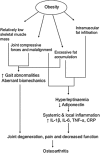Osteoarthritis, obesity and weight loss: evidence, hypotheses and horizons - a scoping review
- PMID: 24751192
- PMCID: PMC4238740
- DOI: 10.1111/obr.12173
Osteoarthritis, obesity and weight loss: evidence, hypotheses and horizons - a scoping review
Abstract
Obesity is widely acknowledged as a risk factor for both the incidence and progression of osteoarthritis, and has a negative influence on outcomes. Loss of at least 10% of body weight, coupled with exercise, is recognized as a cornerstone in the management of obese patients with osteoarthritis, and can lead to significant improvement in symptoms, pain relief, physical function and health-related quality of life. However, questions still remain surrounding optimal management. Given the significant health, social and economic burden of osteoarthritis, especially in obese patients, it is imperative to advance our knowledge of osteoarthritis and obesity, and apply this to improving care and outcomes. This paper overviews what is already known about osteoarthritis and obesity, discusses current key challenges and ongoing hypotheses arising from research in these areas, and finally, postulates what the future may hold in terms of new horizons for obese patients with osteoarthritis.
Keywords: Obesity; osteoarthritis; treatment; weight loss.
© 2014 The Authors. Obesity Reviews published by John Wiley & Sons Ltd on behalf of World Obesity.
Figures


References
-
- Lementowski PW, Zelicof SB. Obesity and osteoarthritis. Am J Orthop (Belle Mead NJ) 2008;37:148–151. - PubMed
-
- Wendelboe AM, Hegmann KT, Biggs JJ, et al. Relationships between body mass indices and surgical replacements of knee and hip joints. Am J Prev Med. 2003;25:290–295. - PubMed
-
- Messier SP, Loeser RF, Miller GD, et al. Exercise and dietary weight loss in overweight and obese older adults with knee osteoarthritis: the Arthritis, Diet, and Activity Promotion Trial. Arthritis Rheum. 2004;50:1501–1510. - PubMed
-
- International Association for the Study of Obesity. Obesity the Global Epidemic. 2013. [WWW document]. URL http://www.iaso.org/iotf/obesity/obesitytheglobalepidemic/ (accessed 4 April 2014)
-
- Hiligsmann M, Cooper C, Arden N, et al. Health economics in the field of osteoarthritis: an expert's consensus paper from the European Society for Clinical and Economic Aspects of Osteoporosis and Osteoarthritis (ESCEO) Semin Arthritis Rheum. 2013;43:303–313. - PubMed
Publication types
MeSH terms
LinkOut - more resources
Full Text Sources
Other Literature Sources
Medical

